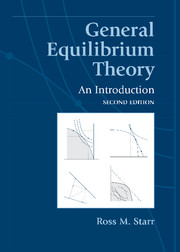Book contents
- Frontmatter
- Contents
- List of illustrations
- Introduction to the second edition
- Preface to the second edition
- Preface to the first edition
- Table of notation
- Table of assumptions
- A General equilibrium theory: Getting acquainted
- B Mathematics
- C An economy with bounded production technology and supply and demand functions
- D An economy with unbounded production technology and supply and demand functions
- E Welfare economics and the scope of markets
- F Bargaining and equilibrium: The core
- G An economy with supply and demand correspondences
- H Standing on the shoulders of giants
- Bibliography
- Index
C - An economy with bounded production technology and supply and demand functions
Published online by Cambridge University Press: 05 June 2012
- Frontmatter
- Contents
- List of illustrations
- Introduction to the second edition
- Preface to the second edition
- Preface to the first edition
- Table of notation
- Table of assumptions
- A General equilibrium theory: Getting acquainted
- B Mathematics
- C An economy with bounded production technology and supply and demand functions
- D An economy with unbounded production technology and supply and demand functions
- E Welfare economics and the scope of markets
- F Bargaining and equilibrium: The core
- G An economy with supply and demand correspondences
- H Standing on the shoulders of giants
- Bibliography
- Index
Summary
In Chapters 11 through 14 we will develop a version of the complete Arrow-Debreu model of the economy. The theory of the firm and production sector is presented in Chapter 11 and that of households and demand in Chapter 12. We bring them together with Walras's Law in Chapter 13 and the existence of general equilibrium in Chapter 14.
As we noted in Chapter 7, the typical characterization of economic activity of firms and households is as a maximization subject to constraint. Recall Corollary 7.2 to Theorem 7.5. For maximization to be well defined, sufficient conditions are that the maximand be a continuous function of its arguments and that the opportunity set be compact. That pretty well sets the agenda for characterizing firm and household behavior. We have to find continuous functions for them to maximize. We should find compact constraint sets for them to do it on. That will characterize firm supply and household demand behavior. Although these are not necessary conditions, they are the best generally sufficient conditions available.
Finding continuous functions for the firm and household to optimize does not pose a problem. For the firm, the obvious choice is profits. For the household, the traditional maximand is utility, though we will go to some effort to derive the continuous utility function from the more primitive assumption of a preference ordering. The obvious constraint set for the firm is a representation of the firm's technically available possibilities – the possible input-output combinations based on available technology represented as a subset of RN.
- Type
- Chapter
- Information
- General Equilibrium TheoryAn Introduction, pp. 109 - 111Publisher: Cambridge University PressPrint publication year: 2011



